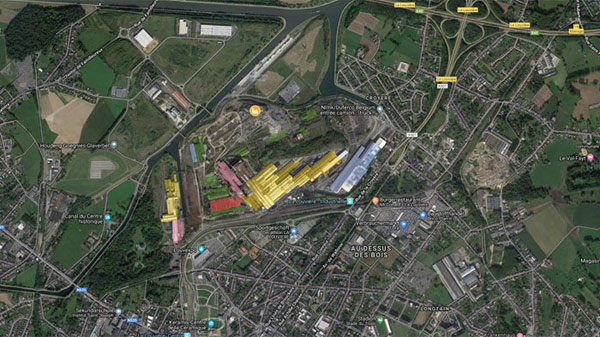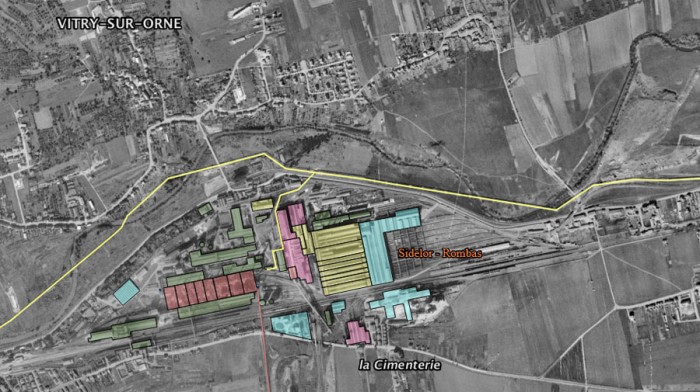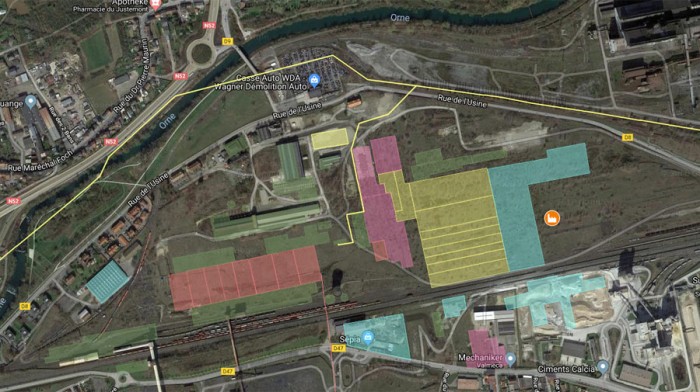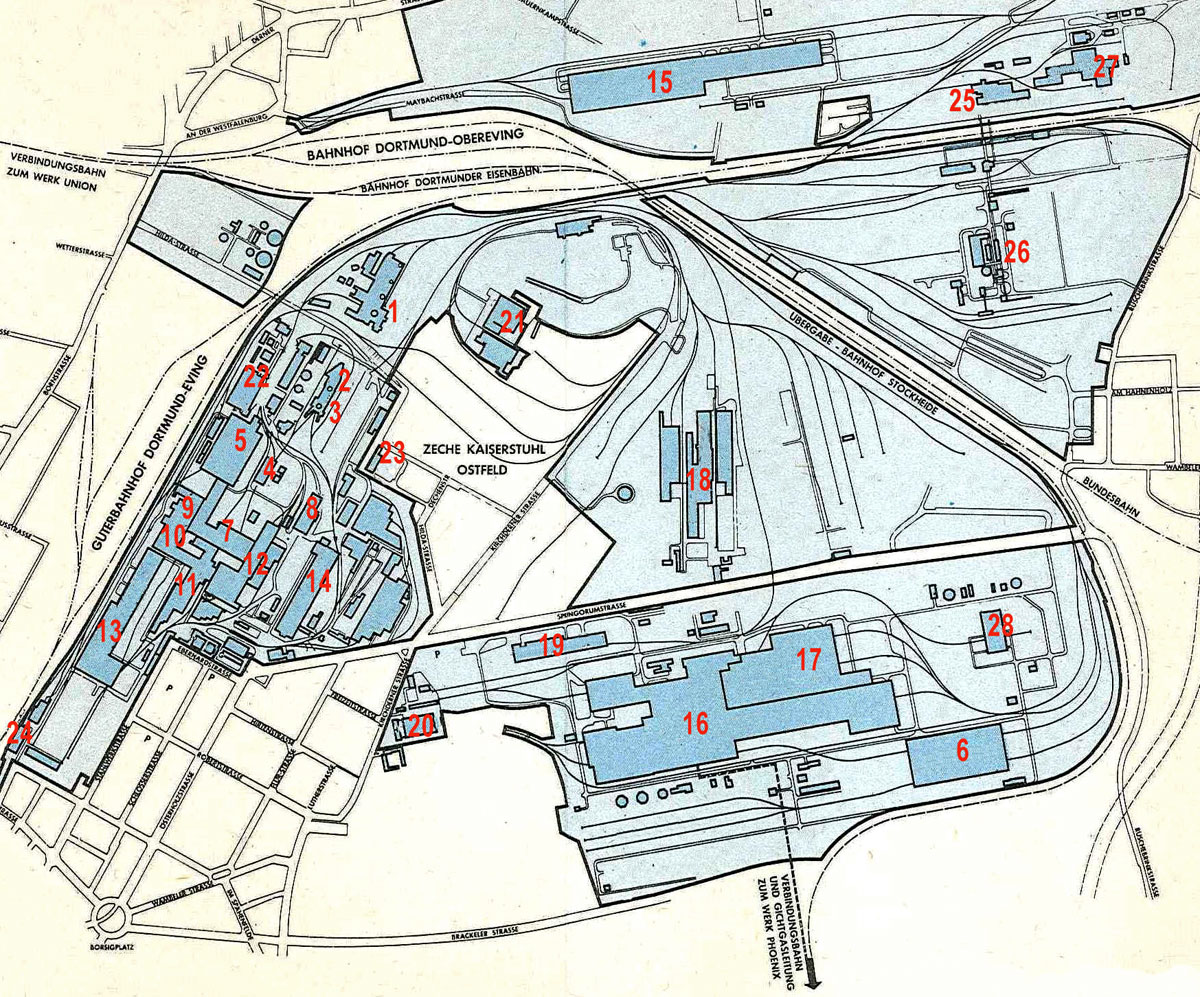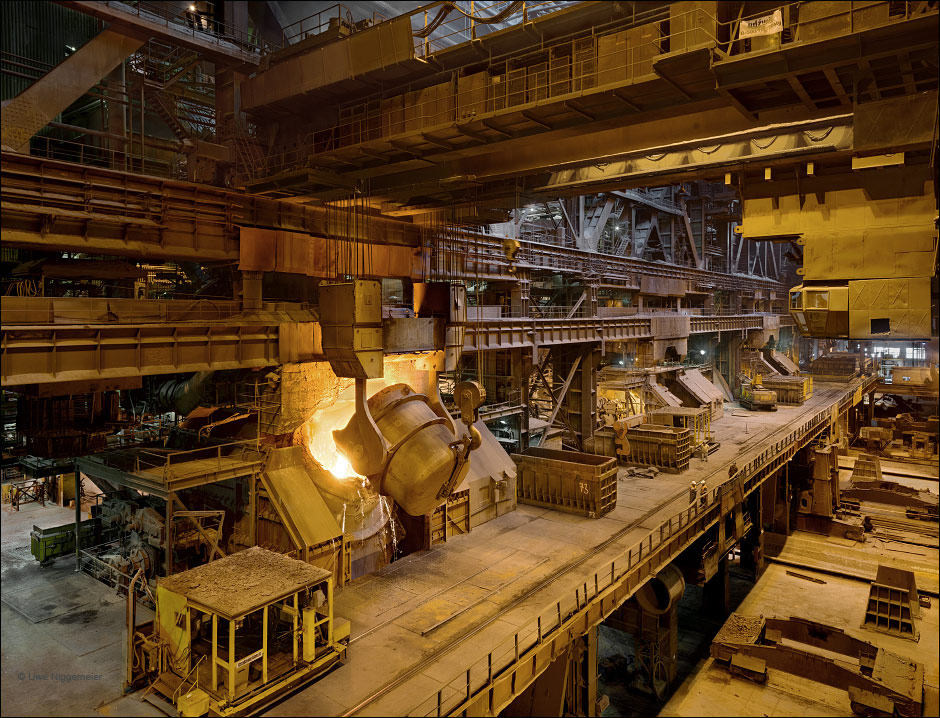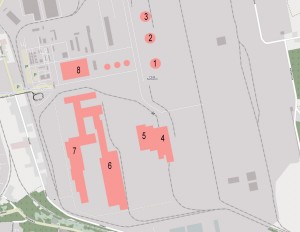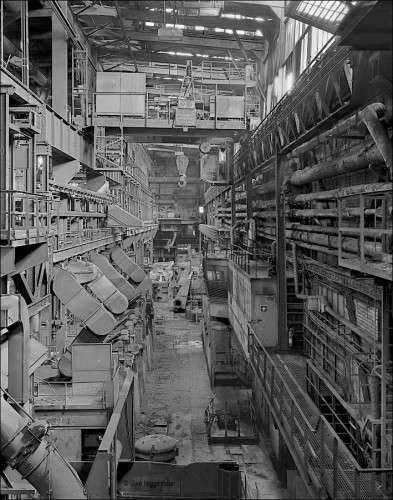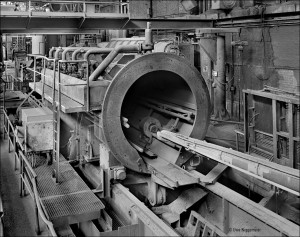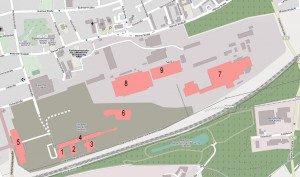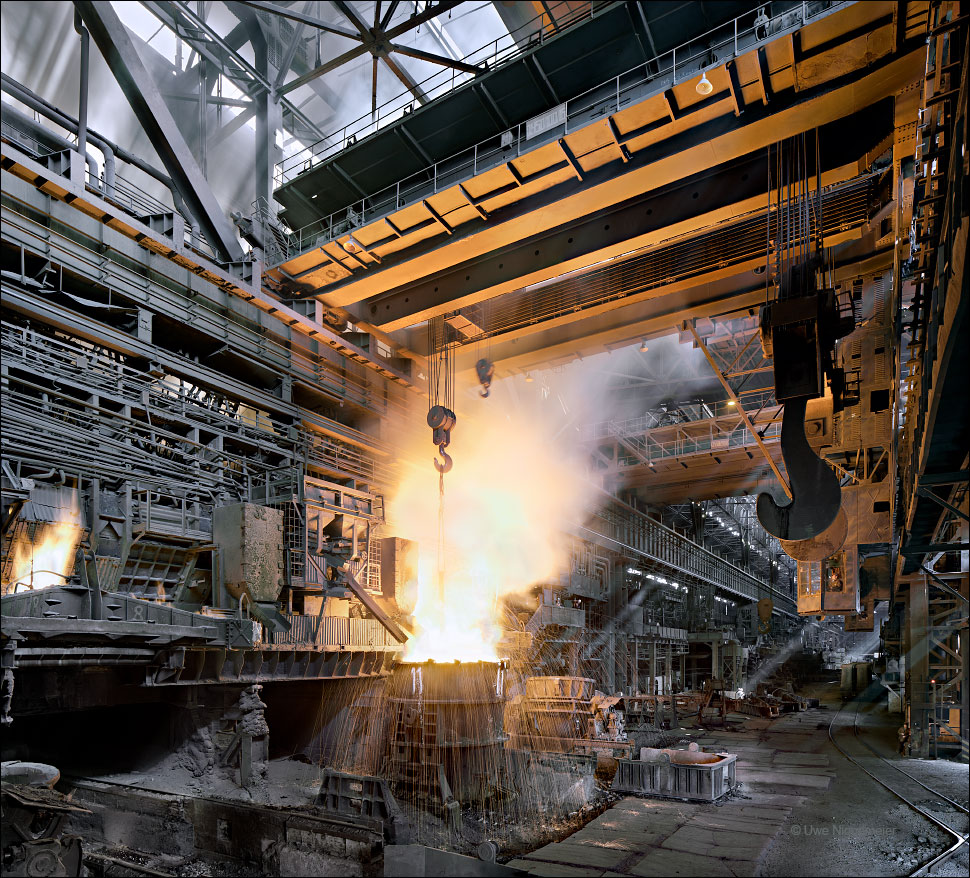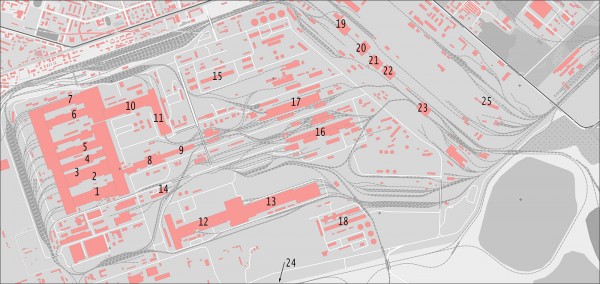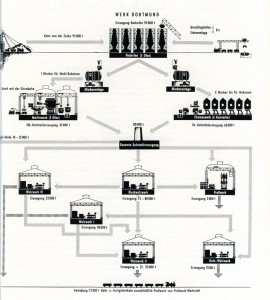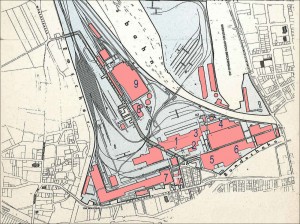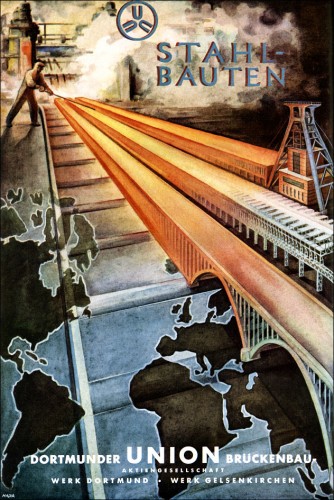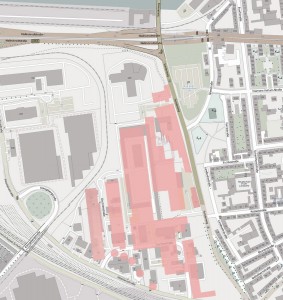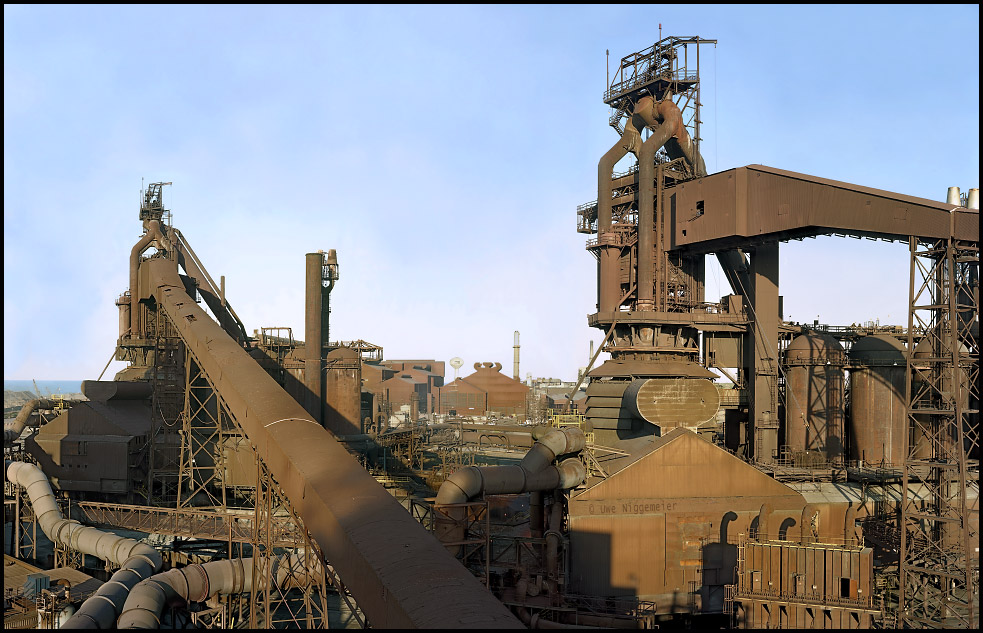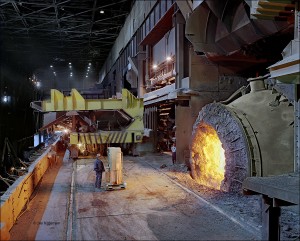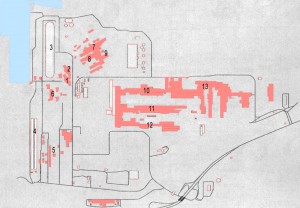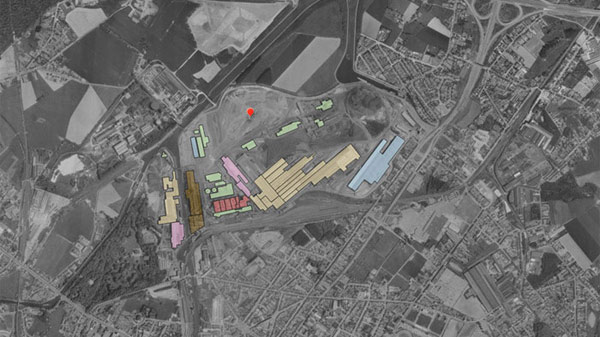
A new map in the collection: Usines Gustave Boel, La Louviere in 1972.
Click on coloured areas for informations.
Tag Archives: Plan
Rivers Of Steel: The Orne
Hoesch Westfalenhütte Ca.1973 (In German)
1: Hochofen IV. 1972-1999.
2: Hochofen VI. 1965-1976
3: Hochofen VII(alt) 1962-1976
4: Roheisenmischer
5: SM-Stahlwerk 2. 1912-1980
6: SM-Stahlwerk 3. 1956-1982
7: Thomasstahlwerk. 1928-1967
8: Elektrostahlwerk. 1955-1985
9: Blockwalzwerk. 1900-1983
10: Fertigstrasse (Schwere Profile). 1900-1968
11: Walzwerk III (Halbzeug). 1888-1966
12: Walzwerke IV/V. -1966
13: Kontinuierliche Halbzeugstrasse. 1955-1983
14: Walzwerk VIII. (Feinstahl). -1957
15: Feineisenstrasse. 1957-1983
16: Warmbreitbandstrasse. 1958-2001
17: Kaltwalzwerk
18: Drahtverfeinerung
19: Schwellenschweisserei
20: Lehrwerkstatt
21: Feuerfest- Steinfabrik
22: Gaszentrale
23: Sauerstoffanlage
24: Walzendreherei
25: Sinterbänder 1/2
26: Sinterband 3. 1961-
27: Zementfabrik
28: Lok-Werkstatt
Some images at Stahlseite.de .
Huta Katowice
The steel mill in Dabrowa Gornica, Poland was built in between 1972 and 1976. It was named “Huta Katowice” after the nearby industrial town.
Three blast furnaces were built in between 1976 and 1987 (hearth diameter 12,00 m).
The mill was taken over by the Mittal Steel Corp. in 2003 and got it’s new name ArcelorMittal Dabrowa Gornica in 2007.
Besides the three blast furnaces (No. 1 is permanently idleld) the mill operates a BOF shop containing three BOF vessels, two continuous casters (one for billets and one for slabs) and two rolling mills (Heavy and medium sections).
Dabrowa Gornica provides primary material for all ArcelorMittal sites in Poland.
The attached coke plant was sold to an external company.
Further images at stahlseite.de .
1: Blast furnace No. 1
2: Blast furnace No. 2
3: Blast furnace No. 3
4: BOF shop
5: Continuous caster
6: Heavy sections rolling mill
7: Medium sections rolling mill
8: Power plant
A BOF Shop For Gelsenkirchen
50 years ago the Rheinstahl AG from Essen, Germany finally cancelled it’s plans to built a BOF shop, a continuous caster and a bar rolling mill at it’s foundry site in Gelsenkirchen.
The Schalker Gruben- und Hüttenverein was founded in 1872 and became Europe’s largest iron foundry after the second world war, employing more than 6000 people. The plans provided an investment of more than 300 Mio.German Marks and an initial capacity of 600.000 tons of steel per year. Though the ground (north of the foundry no.3, next to the Wannerstrasse) was already prepared the whole project was called off due to growing overcapacities on the steel market. So the Schalker Verein stayed an iron foundry with four blast furnaces, a pipe casting mill, two fittings-foundries and a foundry for large castings up to 40 tons a piece
The image shows the melt shop of the pipe casting mill where ductile iron pipes with a diameter up to 1,4 meter were casted. The shop included a 160 ton hot metal mixer and five 13 ton induction furnaces and was built in 1966. The hot metal was provided by the Schalker Verein blast furnaces and later came from Thyssen’s Duisburg Meiderich site (today: Landschaftspark Nord).
The foundry was sold to Thyssen in 1973.The last blast furnace was closed in 1982. The three remaining blast furnaces were demolished in-between April and September of 1983.
The last pipe was casted in 2004 (meanwhile the mill was sold to the French Pont a Mousson/Saint Gobain company). Most of the ground is a redevelopment site by now.
Some historic images at Daniel Hinze’s site.
1: Blast furnace no.1 (Hochofen 1)
2: Blast furnace no.2 (Hochofen 2)
3: Blast furnace no.4 (Hochofen 4)
4: Storage with highline (Möllerbunker)
5: Power station (Kraftzentrale)
6: Sinter plant (Sinteranlage)
7: Pipe foundry (Rohrgiesserei)
8: Fittings foundry no.1 ( Formstückgiesserei 1)
9: Foundry for large castings (Grossgusswerk)
700 Ton Open Hearth Furnace
The steel mill in Kryvyi Rih (Russ. Krivoy Rog) was founded in 1931 on the rich iron or deposits of the Ukrainian Kryvbas basin.
In 1934 the mill was ready to produce hot metal out of one blast furnace. By 1939 three blast furnaces a coke plant and a Bessemer shop were in operation. In the second world war the Kryvyi Rih Metallurgical Works were dismantled by the Soviets and the remains destroyed by the German army.
In 1949 blast furnace No.1 was blown on. By 1960 four rolling mills and a 600 ton open hearth furnace were installed.
Blast furnace No.7 was built in 1962, No. 8 and No. 9 (one of the largest worldwide) followed in 1970 and 1974.
In 1996 the Kryvyi Rih State Mining and Metallurgical Combine (Krivorizhstal) brought together the metallurgical and the mining activities in the Kryvbas basin.
In 2004 the mill was privatized for the first time to an Ukrainian syndicate.
This was canceled one year later and the second privatisation found the Mittal Steel company as a new owner.
Since 2007 Krivorizhstal is part of the worlds largest steel company ArcelorMittal.
Today ArcelorMittal Kryvyi Rih employs 35000 people main products are billets, bars, rod and wire.
Further viewing.
1: Light-section mill 250-2
2: Rod mill 150-1
3: Light-section mill 250-1
4: Light-section mill 250-3
5: Light-section mill 250-4
6: Light-section mill 250-5
7: Rod mill 250-3
8: Blooming mill No.1
9: Soaking pits
10: Blooming mill No.2
11: Soaking Pits
12. Light-section mill 250-6
13: Wire mill
14: Forge shop
15: Oxygen plant
16: BOF shop (6×160 ton)
17: Open hearth shop (1×550 ton, 1×700 ton)
18: Power station
19: Blast furnace No.8
20: Blast furnace No.7
21: Blast furnace No.6
22: Blast furnace No.5
23: Blast furnace No.1
24: Blast furnace No.9
25: Coke plant (6 batteries)
Heavy Rolling
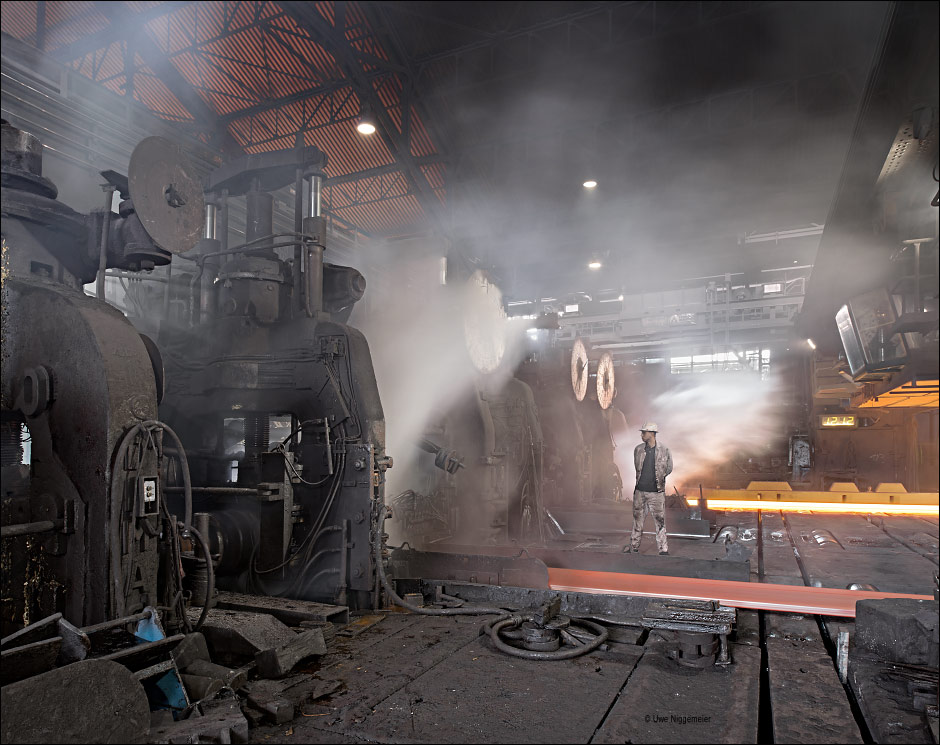
Hoesch Spundwand und Profile (HSP) is the last survivor of the once fully integrated Dortmunder Union steel mill.
The Union AG für Bergbau, Eisen- und Stahl-Industrie was founded in 1872 west of Dortmund in Germany.
In 1881 three blast furnaces were built.
After the Union became part of the Deutsch-Luxemburgische Bergwerks- und Hütten-AG in 1910 an extensive modernisation scheme brought a new Thomas converter melt shop an open hearth shop,a blooming mill and the heavy section mill, called rolling mill NO1, that is partly still in use today.
In 1926 the Union works became part of the Vereinigte Stahlwerke AG from Düsseldorf.
After this company was dismantled after the second world war the Union works joined the Hörder Verein , another steel company from Dortmund, to form the Dortmund Hörder Hüttenunion (DHHU).
In 1957 a continuous medium section rolling mill was erected now called rolling mill NO 2.
In November 1963 the last of the five Union blast furnaces and the Thomas converter steel mill were closed for good.
In 1966 the DHHU was taken over by the Hoesch Stahl AG from Dortmund. The division was called “Werk Union” from now on.
In 1981 the open hearth shop and the rolling mill NO2 were closed.
In 1992 Hoesch was bought by the Krupp company from Essen. Two years later the new subdivision Hoesch Spundwand und Profile was founded.
From 1999 on the remaining rolling mill was part of the ThyssenKrupp Stahl company to be sold to the Salzgitter Stahl company in 2000.
HSP is the only producer of sheet piles and heavy sections in Germany now.
Further images.
1. Heavy sections mill
2. Blooming mill
3. Former Thomas steel mill
4. Open hearth shop
5. Roll lathe plant
6. Forge
7. Medium sections mill
8. Boiler house
9. Repair shops
Dortmunder Union Brückenbau
Once one of the largest engineering companies in Europe (later Rheinstahl Union Brückenbau AG) whose steel bridges are still present everywhere in Germany and that built the Assuan dam in Egypt has nearly disappeared by now.
The workshop south of the Dortmund harbor was famous for it’s 276 meter long and 60 meter wide main hall that housed a bridge assembly line.
This famous structure built in 1898 was torn down in 1995.
Burns Harbor: The last integrated steel mill built in the United States.
50 years ago the Bethlehem Steel Company from Pennsylvania started building a new, state of the art, integrated mill on the banks of the Lake Michigan. 3000 acres of land, neighbouring US Steel’s Gary works, were purchased and construction started in late 1962. Probably few could have imagined that Burns Harbor would be the last integrated mill in the U.S. to be built until today.
In 1964 the 160 “ plate mill was started followed in 1966 by the 80” hot strip mill. In between 1969 and 1972 two blast furnaces, a coke plant (164 coke ovens) and a steel mill, containing two 300 ton BOF vessels were started.In 1975 Bethlehem Steel’s first continuous slab caster started production. In 1978 a 110” plate mill and a third BOF vessel became operational.In 2000 the last ingots were poured.
After filing bankruptcy Bethlehem Steel was taken over by the International Steel Group (ISG) in 2003. Two years later Burns Harbor became part of Mittal Steel USA (ArcelorMittal since 2007).
Further images.
1: Blast furnace C
2: Blast Furnace D
3: Ore storage
4: Coal Storage
5: Coke plant
6: Sinter plant
7: BOF shop
8: Slab caster 1
9: Slab caster 2
10: 80″ hot strip mill
11: 160″ plate mill
12: 110″ plate mill
13: Cold rolling mill
Hoesch Phoenix Works, 1970ies
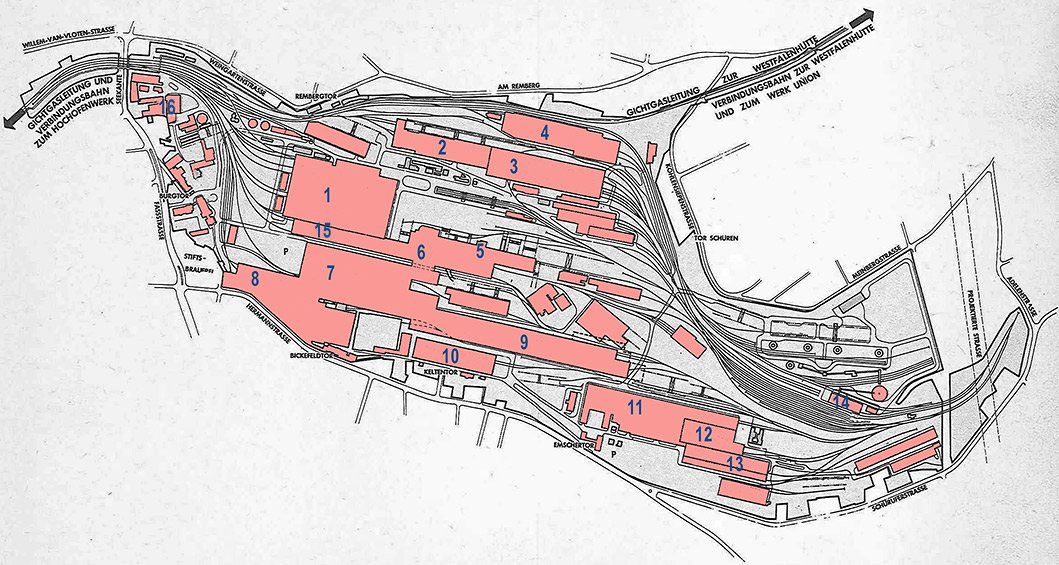 This plan shows the former Hermannshütte in Dortmund-Hörde, Germany, probably in the early 1970ies before the first continuous caster was built:
This plan shows the former Hermannshütte in Dortmund-Hörde, Germany, probably in the early 1970ies before the first continuous caster was built:
- BOF shop (Oxygenstahlwerk) closed 2001
- Open hearth shop IV ,former II (Siemens-Martin Stahlwerk IV, ehem. II) prob. closed in 1971
- Steel foundry (Stahlgiesserei) closed 1987
- Plate storage (Blechlagerhalle)
- Rolling mill 900 (900er Strasse)
- Blooming/slabbing mill (Blockbrammenstrasse) closed prob. 1985
- Heavy plate mill (Grobblechstrasse) closed 1982
- Finishing (Adjustage West)
- Finishing (Adjustage Ost)
- Roller lathe (Walzendreherei)
- Repair shop (Mechanische Werkstatt)
- Welding (Schweisserei)
- Forge (Pressbau)
- Slag mill (Schlackenmühle)
- Soaking pits (Tieföfen)
- Main storage (Zentrallager)
Today the area is transformed into a lake.
Some inside views.

